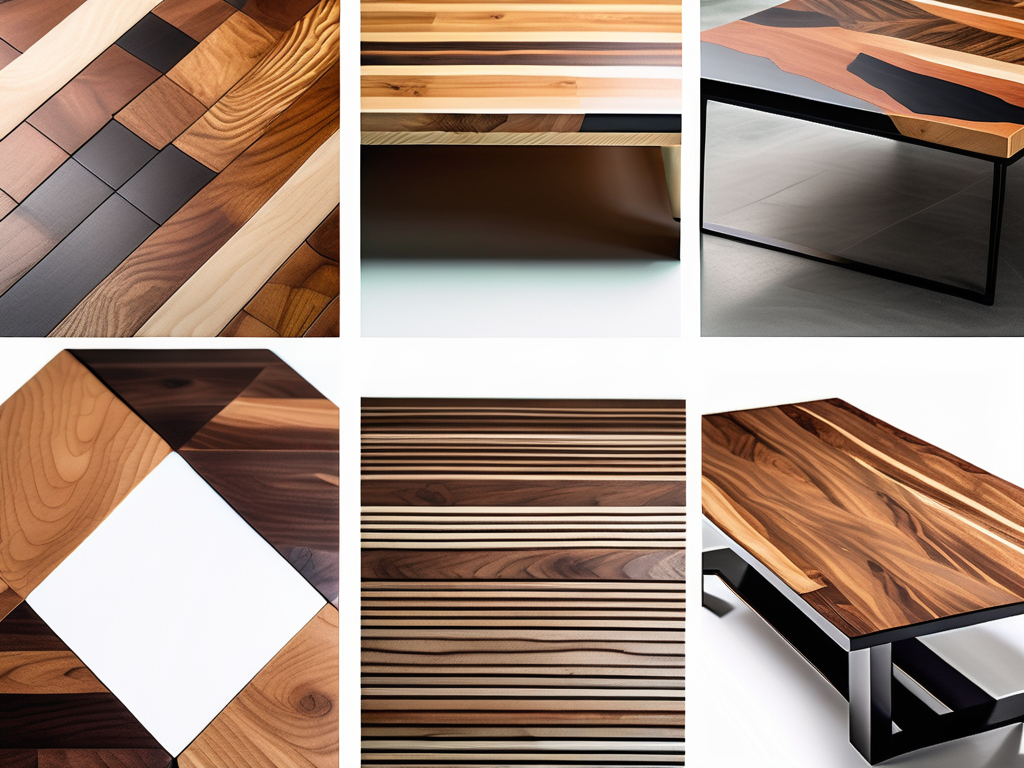When it comes to building coffee tables, choosing the right type of wood is crucial. Not only does it impact the overall aesthetics of the table, but it also affects its durability and longevity. Understanding the importance of wood selection and exploring the top choices available can help you make an informed decision. In this article, we will delve into the world of wood types for coffee tables, discussing the factors to consider, the characteristics of different woods, and the pros and cons of each option.
Understanding the Importance of Wood Selection
Wood plays a significant role in furniture making, particularly in the construction of coffee tables. As the primary material, wood determines the overall strength, stability, and appearance of the table. It can add warmth, charm, and character to your living space, creating a focal point that ties the room together.
When selecting the perfect wood for your coffee table, it’s essential to delve deeper into the world of woodworking. Different wood species offer unique characteristics that can greatly impact the final product. For example, oak is known for its durability and prominent grain patterns, while cherry wood boasts a rich, reddish hue that deepens over time. Each type of wood has its own story to tell, adding layers of meaning to your furniture piece.
The Role of Wood in Furniture Making
Wood is valued for its versatility and natural beauty. It can be shaped, carved, and finished to create unique designs and intricate details. In addition to its aesthetic qualities, wood also offers structural integrity, making it a reliable choice for building sturdy coffee tables.
Furthermore, the sustainability of wood should not be overlooked in the selection process. Opting for responsibly sourced wood ensures that your furniture choice has a minimal impact on the environment. Look for certifications such as FSC (Forest Stewardship Council) to guarantee that the wood used in your coffee table comes from well-managed forests that promote biodiversity and community welfare.
Factors to Consider in Choosing Wood for Coffee Tables
When selecting wood for your coffee table, several factors should be taken into account. First and foremost, consider the level of durability required. Coffee tables are subjected to daily use and potential wear and tear, so it’s crucial to choose a wood type that can withstand these demands. Additionally, consider the aesthetic appeal, as different woods have distinct grains, colors, and textures that can complement your existing decor. Lastly, factor in your budget, as some wood types may be more expensive than others.
An Overview of Wood Types
Before we dive into the specific wood types for coffee tables, let’s familiarize ourselves with the two broad categories: hardwoods and softwoods.
Hardwoods vs Softwoods: What’s the Difference?
Contrary to what the names might suggest, the terms “hardwood” and “softwood” do not solely refer to the density or hardness of the wood itself. In fact, some hardwoods are softer than certain softwoods. The main distinction between the two lies in the classification of the tree species. Hardwoods come from deciduous trees, such as oak, maple, and teak, while softwoods are obtained from coniferous trees, such as pine, fir, and cedar.
Hardwoods are known for their durability and strength, making them ideal for furniture that needs to withstand daily use. They also tend to have more intricate grain patterns and richer colors compared to softwoods. Softwoods, on the other hand, are generally easier to work with due to their softer nature, making them a popular choice for construction projects and outdoor furniture.
The Unique Characteristics of Each Wood Type
Now that we understand the basic categories, let’s explore the unique characteristics of some popular wood types used for coffee tables.
Oak is a hardwood known for its strength and durability. It has a prominent grain pattern that adds a touch of elegance to furniture pieces. Maple, another hardwood, is prized for its light color and smooth texture, making it a popular choice for modern and minimalist designs. Teak, a tropical hardwood, is highly resistant to moisture and insects, making it a top choice for outdoor furniture.
Exploring the Top Choices for Coffee Tables
The Classic Appeal of Oak
Oak is a hardwood known for its strength, durability, and timeless beauty. It features a prominent grain pattern, which adds visual interest to any coffee table. Oak is available in various shades, from light to dark, enabling you to choose the tone that best suits your space. This wood type can withstand daily use and is resistant to scratches and dents, making it an excellent choice for families or those who frequently host guests.

Furthermore, oak is a sustainable choice for environmentally conscious consumers. The slow growth rate of oak trees results in a dense and sturdy wood, perfect for furniture that is built to last. Additionally, oak is relatively easy to maintain, requiring simple polishing to keep its luster and beauty intact for years to come.
The Durability of Maple
Maple is another hardwood that is highly favored for coffee tables. Its light-colored wood with a smooth and uniform grain offers a modern and minimalist aesthetic. Maple is known for its exceptional durability, making it resistant to warping and damage. It is also less prone to shrinking and expanding due to changes in humidity, ensuring that your coffee table remains stable and intact over time.
In addition to its durability, maple is a versatile wood that can be easily stained or painted to match different decor styles. Whether you prefer a natural wood look or a bold pop of color, maple coffee tables offer a customizable option to suit your design preferences.
The Exotic Charm of Teak
When it comes to exotic woods, teak is a popular choice for coffee tables. Its rich golden-brown color and distinctive grain patterns create a visually stunning piece of furniture. Teak is highly resistant to moisture, decay, and insects, making it an ideal option for both indoor and outdoor coffee tables. Its natural oils also contribute to its durability, ensuring that your teak coffee table will last for years to come.
Furthermore, teak is a sustainable choice due to its abundance and renewability. Harvested from responsibly managed plantations, teak is a wood that not only adds elegance to your space but also aligns with eco-friendly practices. Investing in a teak coffee table not only enhances your decor but also supports sustainable forestry efforts worldwide.
The Pros and Cons of Popular Wood Types
Weighing the Benefits and Drawbacks of Oak
Oak offers several advantages as a wood type for coffee tables. Its strength and durability make it a long-lasting choice, capable of withstanding heavy daily use. Additionally, oak’s distinct grain pattern and wide range of color options allow for a customizable and visually appealing coffee table. The natural beauty of oak can bring warmth and character to any living space, creating a cozy and inviting atmosphere. Whether you prefer a rustic or traditional decor style, oak can effortlessly blend in and enhance the overall aesthetic.
However, oak can be relatively more expensive compared to other wood types, and some may find its traditional aesthetic less suitable for contemporary or modern decor styles. Despite its durability, oak may require occasional maintenance to preserve its appearance and protect it from potential damage. With proper care, an oak coffee table can become a cherished piece of furniture that lasts for generations, adding value to your home.
Considering the Strengths and Weaknesses of Maple
Maple is renowned for its durability and stability, making it highly suitable for coffee tables. Its light color and smooth grain give it a clean and sleek appearance that complements a variety of interior styles. Maple’s versatility allows it to effortlessly adapt to both traditional and modern decor, making it a popular choice among homeowners and interior designers alike.
However, maple can be more susceptible to scratching compared to other hardwoods, and its light color may show wear and tear more prominently over time. Regular maintenance and protective measures can help alleviate these concerns and keep your maple coffee table looking pristine. With proper care, a maple coffee table can serve as a timeless centerpiece in your living room, providing both functionality and aesthetic appeal.
Evaluating the Advantages and Disadvantages of Teak
Teak stands out for its exotic beauty and impressive durability. Its natural oils and high density contribute to its resistance against moisture, stains, and insects. Teak coffee tables can be a valuable investment, as they age gracefully and develop a desirable silvery-gray patina over time. The unique characteristics of teak make it a statement piece that adds a touch of elegance and sophistication to any space.
However, the exoticism and durability of teak come at a higher price point, making it a premium choice for coffee table enthusiasts. The luxurious appeal of teak can elevate the overall ambiance of your living room, creating a sense of opulence and refinement. Investing in a teak coffee table not only adds value to your home but also allows you to enjoy its beauty and functionality for years to come.
Caring for Your Wooden Coffee Table
Maintenance Tips for Oak Coffee Tables
To keep your oak coffee table looking its best, regular dusting and occasional polishing are recommended. Avoid placing hot or wet objects directly on the surface, as this could cause discoloration or damage. Additionally, consider using coasters and trivets to protect the wood from potential scratches or water rings.
How to Keep Your Maple Table Looking New
Maintaining the beauty of your maple coffee table starts with proper care. Clean the surface regularly with a soft, damp cloth and mild soap, avoiding harsh chemicals that can strip the wood’s natural finish. Apply a suitable wood polish or wax to restore and enhance the luster of the maple. Avoid exposing the table to direct sunlight, as this can cause fading and discoloration.
Preserving the Beauty of Your Teak Coffee Table
To ensure the longevity of your teak coffee table, regular cleaning and oiling are essential. Use a soft brush or cloth to remove dirt and debris from the surface. Apply teak oil or sealant to nourish the wood and protect it from moisture. Periodically sanding the table can help maintain its smooth finish. Keep in mind that teak tables left outdoors may require more frequent maintenance due to exposure to the elements.
In conclusion, the choice of wood for your coffee table goes beyond aesthetics. It impacts the table’s durability, stability, and overall quality. Each wood type, whether oak, maple, or teak, offers unique characteristics and advantages. Consider your specific needs, budget, and desired aesthetic when making your selection. With proper care and maintenance, your chosen wooden coffee table will serve as a functional and beautiful centerpiece in your living space for years to come.
Ready to elevate your living space with a coffee table that combines style, durability, and affordability? Look no further than Artum Hill Furniture. Our selection of fashion-forward coffee tables is designed to complement any room, ensuring you find the perfect centerpiece to match your design preferences. Shop Now at Artum Hill Furniture and bring your ideal living space to life with high-quality furniture that doesn’t break the bank.
